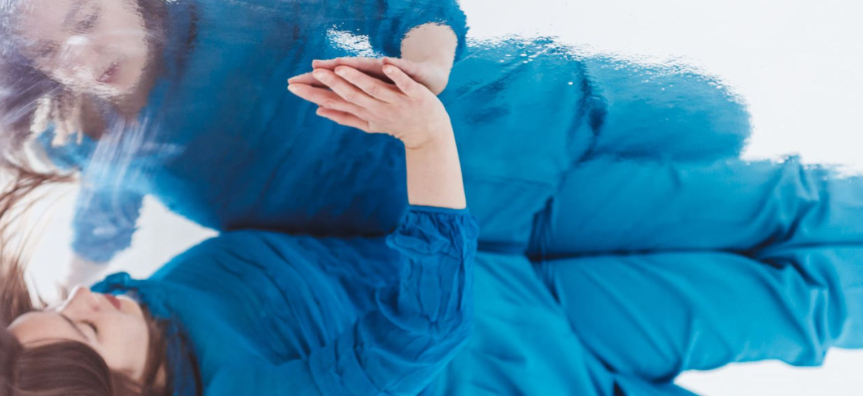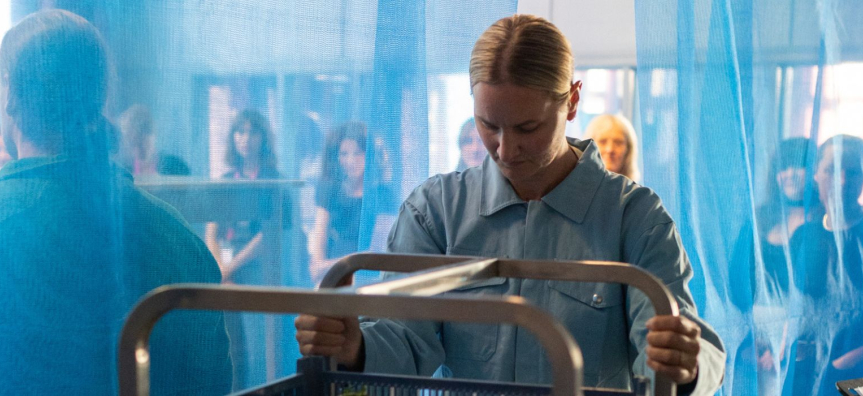
Local Creative - Kate Butcher
Kate Butcher (she/her) is an Australian visual artist and producer currently based between the Northern Beaches and Norway. She holds a Bachelor of Fine Art from The National Art School in Sydney, and a Master's degree in Fine Art from Trondheim Academy of Fine Arts. With a diverse artistic practice, Katherine's work spans various mediums, collaborations, and 'making public' formats.
The ‘About’ page of your website has two playfully serious-looking images side by side. One is a photo of you roughly painting your own face, the other is an animated GIF, in a highly pixelated bitmap style, that appears to be an interpretation of your painted face.
This feels like a wonderful analogy for your work. You physically perform in a lot of your work, you present alternate perspectives on the world around you, and you play a lot with technology and how it can reframe physical objects and actions.
How do you approach the use of physical performance, visual art, and technology in your work?
When developing a new artistic work I often wrestle between thinking about it as a total final form, the object or material outcome that would become public, and the smaller instinctive decisions and actions I need to take to move towards that idea.
Being open to engaging with different visual expressions such as my body, traditional visual materials, and digital technologies, is probably in line with this, and in part a personality trait. I see this approach as enabling me to interact more fully with an idea in time and space.
Recently you’ve been experimenting with LiDAR, a 3D scanning technology used by surveyors in the construction industry.
Can you explain more about how this technology works, how you’re using it, and perhaps why you chose to use it in your work?
Spatial scanning like LiDAR was used by NASA in the 1970s to develop its exploration spacecraft. Today this technology is utilised by developers to plan our new living spaces and adopted by councils to re-map, with high precision, landscapes and spaces with natural hazards. It is used for game design, creative works and film making. The technology uses laser light to measure distances on Earth by sending out pulses of light and recording the time it takes to bounce back, like sonar but with light instead of sound.
During my residency, I have the opportunity to experiment with a handheld LiDAR scanner to capture detailed 3D images of the Eramboo site (adjacent to the Ku-ring-gai National Park). I'm now working on how to weave a new personal performance into this mass of collected data. This process is taking place through some incredible game design software. What will be 'produced' I can't fully say, but I would describe the process as a digital site-specific still life with some fun world-building.
When we met at the beginning of your residency, you said “I like not knowing the answer”. You’ve also expressed this poetically when writing about your project, My Anteroom Has Eyes:
“I certainly have no answer. I only have your questions as the cradle for hoped-for answers, which may dance in or never appear.”
Creative people are often in this space of ‘not knowing’, and it can be incredibly uncomfortable, or terrifying at times. You seem quite comfortable with it. How do you manage being in that ‘lost’ frame of mind, and how is it productive for you.
The quote was a beautiful expression used by French writer and playwright Hélène Cixous during a filmed interview for the Perpetual Peace Project, in which she posited that our actions are responses to perceived questions or demands that we meet with an answer. My answers to your questions here in this interview may or may not perform, or as Hélène puts it, 'never appear' and 'dance'.
I think this also motivates me when I work and think about climate change and our response to the environment. A good framework for being in 'not knowing' is the question 'with what ambition?
Knowing and not knowing often go together: in my site work at Eramboo, I look at the public tools and information available, such as the NSW Government's climate change information on AdaptNSW, which shows projected rainfall and temperatures for my residence studio address. I can look at these projections for Eramboo's 'near future 2020-2039' and 'far future 2060-2079', but remain overwhelmed by not knowing how to proceed. Not knowing is a strong motivator for me, or desire, dreaming and hoping, which are the makings of a second reality (Hélène again). It is in this space that I believe people operate when they imagine a better, fairer and more peaceful world.
As part of your residency at Eramboo you have offered emerging artists a mentorship with you in a small group setting. (Applications now closed.)
Who have been impactful mentors in your career, and why do you feel mentorship is important?
I am looking forward to meetings with artists from the Northern Beaches next month. In terms of mentoring, I like the description 'generative meetings' simply because we all have something to learn from each other.
In my own practice, I have been most rewarded by the peer-to-peer relationships found in the artist collectives and artist-run initiatives I have been involved with. Artistic spaces are often characterised as uncertain spaces. In practice this looks like short-term or no contracts in place, or places that are being considered for future development for profit. This means that artists can operate in-between economic interests and decision-makers and although it can be a resource-poor community, it's almost in the business of imagining a second reality.
Gathering is an incredibly important part of my artistic practice and a model for community building.



